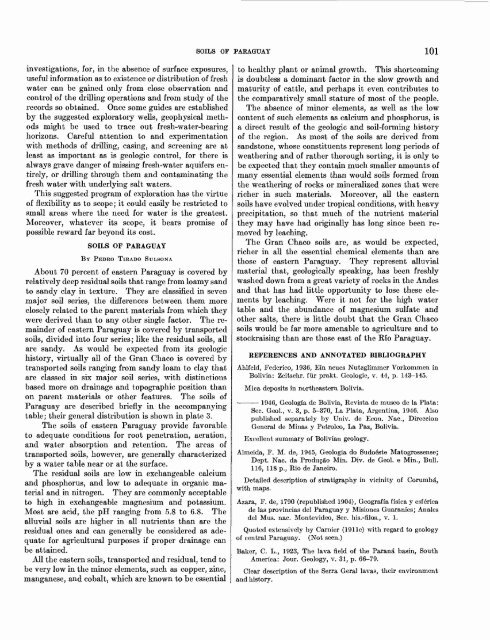Geology and Mineral Resources of Paraguay A Reconnaissance
Geology and Mineral Resources of Paraguay A Reconnaissance
Geology and Mineral Resources of Paraguay A Reconnaissance
- No tags were found...
You also want an ePaper? Increase the reach of your titles
YUMPU automatically turns print PDFs into web optimized ePapers that Google loves.
SOILS OF PARAGUAY 101investigations, for, in the absence <strong>of</strong> surface exposures,useful information as to existence or distribution <strong>of</strong> freshwater can be gained only from close observation <strong>and</strong>control <strong>of</strong> the drilling operations <strong>and</strong> from study <strong>of</strong> therecords so obtained. Once some guides are establishedby the suggested exploratory wells, geophysical methodsmight be used to trace out fresh-water-bearinghorizons. Careful attention to <strong>and</strong> experimentationwith methods <strong>of</strong> drilling, casing, <strong>and</strong> screening are atleast as important as is geologic control, for there isalways grave danger <strong>of</strong> missing fresh-water aquifers entirely,or drilling through them <strong>and</strong> contaminating thefresh water with underlying salt waters.This suggested program <strong>of</strong> exploration has the virtue<strong>of</strong> flexibility as to scope; it could easily be restricted tosmall areas where the need for water is the greatest.Moreover, whatever its scope, it bears promise <strong>of</strong>possible reward far beyond its cost.SOILS OF PARAGUAYBY PEDEO TIRADO SULSONAAbout 70 percent <strong>of</strong> eastern <strong>Paraguay</strong> is covered byrelatively deep residual soils that range from loamy s<strong>and</strong>to s<strong>and</strong>y clay in texture. They are classified in sevenmajor soil series, the differences between them moreclosely related to the parent materials from which theywere derived than to any other single factor. The remainder<strong>of</strong> eastern <strong>Paraguay</strong> is covered by transportedsoils, divided into four series; like the residual soils, allare s<strong>and</strong>y. As would be expected from its geologichistory, virtually all <strong>of</strong> the Gran Chaco is covered bytransported soils ranging from s<strong>and</strong>y loam to clay thatare classed in six major soil series, with distinctionsbased more on drainage <strong>and</strong> topographic position thanon parent materials or other features. The soils <strong>of</strong><strong>Paraguay</strong> are described briefly in the accompanyingtable; their general distribution is shown in plate 3.The soils <strong>of</strong> eastern <strong>Paraguay</strong> provide favorableto adequate conditions for root penetration, aeration,<strong>and</strong> water absorption <strong>and</strong> retention. The areas <strong>of</strong>transported soils, however, are generally characterizedby a water table near or at the surface.The residual soils are low in exchangeable calcium<strong>and</strong> phosphorus, <strong>and</strong> low to adequate in organic material <strong>and</strong> in nitrogen. They are commonly acceptableto high in exchangeable magnesium <strong>and</strong> potassium.Most are acid, the pH ranging from 5.8 to 6.8. Thealluvial soils are higher in all nutrients than are theresidual ones <strong>and</strong> can generally be considered as adequatefor agricultural purposes if proper drainage canbe attained.All the eastern soils, transported <strong>and</strong> residual, tend tobe very low in the minor elements, such as copper, zinc,manganese, <strong>and</strong> cobalt, which are known to be essentialto healthy plant or animal growth. This shortcomingis doubtless a dominant factor in the slow growth <strong>and</strong>maturity <strong>of</strong> cattle, <strong>and</strong> perhaps it even contributes tothe comparatively small stature <strong>of</strong> most <strong>of</strong> the people.The absence <strong>of</strong> minor elements, as well as the lowcontent <strong>of</strong> such elements as calcium <strong>and</strong> phosphorus, isa direct result <strong>of</strong> the geologic <strong>and</strong> soil-forming history<strong>of</strong> the region. As most <strong>of</strong> the soils are derived froms<strong>and</strong>stone, whose constituents represent long periods <strong>of</strong>weathering <strong>and</strong> <strong>of</strong> rather thorough sorting, it is only tobe expected that they contain much smaller amounts <strong>of</strong>many essential elements than would soils formed fromthe weathering <strong>of</strong> rocks or mineralized zones that werericher in such materials. Moreover, all the easternsoils have evolved under tropical conditions, with heavyprecipitation, so that much <strong>of</strong> the nutrient materialthey may have had originally has long since been removedby leaching.The Gran Chaco soils are, as would be expected,richer in all the essential chemical elements than arethose <strong>of</strong> eastern <strong>Paraguay</strong>. They represent alluvialmaterial that, geologically speaking, has been freshlywashed down from a great variety <strong>of</strong> rocks in the Andes<strong>and</strong> that has had little opportunity to lose these elements by leaching. Were it not for the high watertable <strong>and</strong> the abundance <strong>of</strong> magnesium sulfate <strong>and</strong>other salts, there is little doubt that the Gran Chacosoils would be far more amenable to agriculture <strong>and</strong> tostockraising than are those east <strong>of</strong> the Rio <strong>Paraguay</strong>.REFERENCES AND ANNOTATED BIBLIOGRAPHYAhlfeld, Federico, 1936, Ein neues Nutzglimmer Vorkommen inBolivia: Zeitschr. filr prakt. Geologic, v. 44, p. 143-145.Mica deposits in northeastern Bolivia.1946, Geologfa de Bolivia, Re vista de museo de la Plata:Sec. Geol., v. 3, p. 5-370, La Plata, Argentina, 1946. Alsopublished separately by Univ. de Econ. Nac., DireccionGeneral de Minas y Petroleo, La Paz, Bolivia.Excellent summary <strong>of</strong> Bolivian geology.Almeida, F. M. de, 1945, Geologia do Sudoe"ste Matogrossense;Dept. Nac. da Produgao Min. Div. de Geol. e Min., Bull.116, 118 p., Rio de Janeiro.Detailed description <strong>of</strong> stratigraphy in vicinity <strong>of</strong> Corumba,with maps.Azara, F. de, 1790 (republished 1904), Geografia fisica y esfericade las provincias del <strong>Paraguay</strong> y Misiones Guara.nies; An alesdel Mus. nac. Montevideo, Sec. his.-filos., v. 1.Quoted extensively by Carnier (191 Ic) with regard to geology<strong>of</strong> central <strong>Paraguay</strong>. (Not seen.)Baker, C. L., 1923, The lava field <strong>of</strong> the Parana basin, SouthAmerica: Jour. <strong>Geology</strong>, v. 31, p. 66-79.Clear description <strong>of</strong> the Serra Geral lavas, their environment<strong>and</strong> history.
















